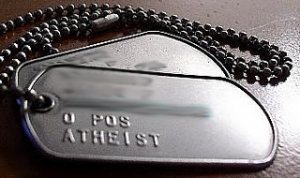Humanist Chaplains and Conscientious Objectors

By E. James Lieberman
The claim that there are no atheists in foxholes is false. The armed forces include the whole spectrum of belief, even in the heat of battle. More important is the fact that there are conscientious objectors in the military today—some religious, some not. Since there is no draft, the only conscientious objectors in uniform are those unfamiliar with traditional peace churches; only after enlistment do they realize that they cannot participate in war. They have a difficult time trying to leave the military without getting an undesirable discharge.
The Center on Conscience & War (CC&W), founded in 1940 as the National Service Board for Religious Objectors, has grown from a small group of traditional peace churches (Quaker, Mennonite, Brethren) to be more inclusive. The CC&W advisory board includes dozens of organizations including the American Humanist Association. Roy Speckhardt recently told CC&W director, Maria Santelli and me about the AHA’s effort, with the Military Association of Atheists and Freethinkers, to introduce humanist chaplains into the armed forces. The fact that evangelical chaplains—the vast majority—are against it is upsetting, even if not surprising. CC&W often consults with military chaplains, and now includes one (retired) on its board.
A long history of wars and the constant exhibits of violence in our news and entertainment hide the fact that conscientious objection is—though undeclared—the everyday status of almost every human being, the default position. Only three percent kill easily, or at all. These aggressive psychopaths get a disproportionate share of publicity despite (and because of) their abnormality. The media thrive on stories of shocking, atypical behavior, so people think what is rare and scary is common.
Non-human social animals have an instinctive mechanism to prevent lethal fights–and we do too. Excepting rare circumstances like defending a loved one from imminent attack, most humans find it easier to die than to kill. Just as a defeated wolf exposes his neck (jugular) to the winner, stopping the fight, so “turning the other cheek” preserves the human species. Most killing in war is from a distance (bombs, artillery), directed by persuasive authority, political and religious. Up to and including World War II, 80 percent of troops would not shoot to kill a visible enemy. West Point psychologist Lt. Col. Dave Grossman in On Killing cites compelling evidence that most soldiers only pretended to load and shoot, or would aim to miss oncoming troops. Killing a retreating soldier—shooting him in the back—is much easier. Because there were so many conscientious objectors in uniform, training techniques changed in the 1960s, enabling 90 percent of our troops to shoot to kill in Vietnam and subsequent wars. But that gain was associated with PTSD, disability, and suicide in veterans, conditions that are increasingly, and accurately, being recognized as symptoms of moral injury resulting from the violation of one’s conscience.
Traditional clergy serving our troops need to recognize the cost of suspending the Sixth Commandment. Humanist chaplains are more likely to understand that good conscience does not, and should not, simply yield to authority—religious or secular. This could explain why evangelicals are opposed to the American Humanist Association’s proposal. American exceptionalism means never having to apologize for what our nation does in the name of defense. Established authoritarian religion tends to support that stance.
E. James Lieberman, M.D., Clinical Professor of Psychiatry, emeritus at the George Washington University School of Medicine, represents the Jewish Peace Fellowship on the Board of the Center on Conscience & War.
